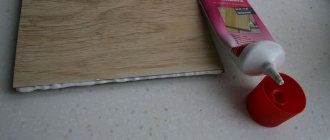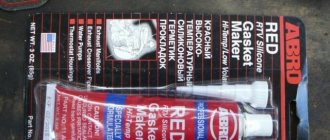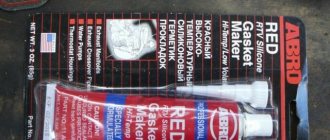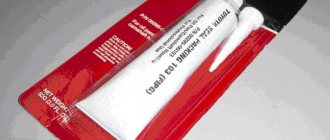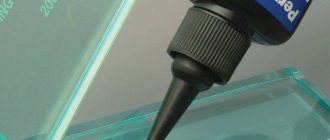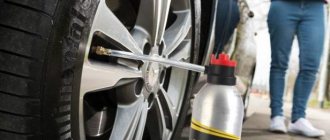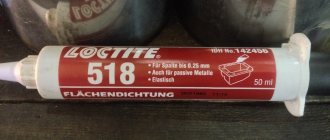ABRO® is a brand of an American company that, since 1939, has been developing unique formulations in accordance with market conditions and needs.
The company also has products in its assortment, for example, sealants, which are especially loved by both car enthusiasts and professional mechanics.
If you service your car yourself or do professional repairs, then you have probably used ABRO sealant at least once.
What sealants does ABRO produce? What are their features and uses? How can I remove old sealant?
Next we will try to answer these and other questions.
Scope of application of sealants
Abro sealant is intended for repair, partial or complete replacement of any type of car gaskets, for sealing joints, filling seams and gluing glass. It is suitable for working with trucks, passenger vehicles and other equipment.
When applied to surfaces, the sealant can take the desired shape and withstands squeezing, stretching, and movement. "Abro" is not afraid of water and oils, auto chemicals and petroleum products, so it is ideal as a car product.
ABRO sealant
ABRO Multi-Purpose Sealant is designed to repair or replace most types of gaskets found on vehicles. It is made on the basis of silicone and polymers, has high elasticity and strength, is able to take absolutely any shape, and hardens instantly. ABRO silicone sealant successfully withstands tension, compression and shear and is not destroyed at all under the influence of water, automobile oils and antifreeze. It also has high resistance to brake fluid and gasoline.
Types of Abro sealants
Depending on the composition and curing characteristics, all Abro sealants are divided into several groups.
High temperature
This sealant can withstand heating up to +371 degrees, and is characterized by a high tensile strength (14.55 kg/sq. cm). This silicone composition has a red color due to the presence of a finely dispersed pigment of the appropriate shade, and does not contain metals.
Due to the absence of metal particles, it boasts electrical insulating properties. Red sealant does not contain acids and does not emit harmful substances when heated, but is not suitable for surfaces that come into contact with gasoline.
Other characteristics of the product:
- retains its shape during vibration, pulsation,
- withstands destruction
- drying within 24 hours
- gives an even flexible seam after polymerization,
- allows you to make gaskets up to 6 mm thick.
Silicone acid
A by-product of polymerization is the release of acetic acid, which is present in their composition. After application, you can immediately notice an unpleasant sour odor emanating from the sealant. The price of such products is the least high, so they are the most popular for forming gaskets in auto repair.
The properties and technical parameters of silicone acid sealants are as follows:
- optimal curing speed - up to 24 hours,
- ease of use,
- operation at temperatures up to +260 degrees,
- high degree of adhesion to materials.
These products should be used with caution when working with metal substrates - in some cases they can provoke corrosion. Most of all, such compositions are suitable for working with different types of plastic.
Silicone neutral
Neutral sealants do not contain acids, therefore they do not react with metals and are suitable for working with iron, copper, and various alloys. Silicone-based products can be used at temperatures up to +200...+260 degrees, and those containing copper dust can withstand temperatures up to +343 degrees. Sealants are compatible with any technical fluids, exhibit high adhesion to all surfaces, and are almost odorless.
Series 1100 and 1200
Sealants from these series have similar characteristics. They are operated in a temperature range of –50…+200 degrees and can be used for interior and exterior work. The compositions are excellent for forming gaskets, creating insulation, and sealing seams on products made of rubber, wood, metal, ceramics and other materials.
Sealing agents include antifungal and antiseptic components that prevent the growth of microbes and mold. The sealants of the series are moisture resistant, not afraid of vibrations, deformations: the seam remains flexible even when stretched by 25%. They are available in white, black, transparent versions.
Application
To correctly apply Abro 9-AB-R gray sealant, you must first disassemble the unit for which it is going to be used. It is advisable to remove all parts, fragments and parts of the old unnecessary gasket. At the same time, it is very important to do all this carefully, do not damage or scratch metal surfaces. It is also necessary to remove all excess dirt, dust, grease and oil traces from the parts.
Having picked up a can of sealant, you need to shake it thoroughly and shake it. This is done for 10 to 30 seconds so that all the liquid inside is thoroughly mixed.
The cylinder is held relative to the surface being treated at a certain angle, approximately equal to 45 degrees cm. Abro OEM 999 Gasket Maker sealant is applied slowly, along the entire perimeter of the part, while maintaining a layer thickness of 2 to 3 millimeters.
The part is applied and strongly compressed, while all the fastening bolts holding it are tightened, evenly, without jerking or over-tightening. After the work has been done, you need to take a dry cloth and remove excess (squeezed out when tightening the fastening bolts) sealant from the parts.
The minimum time for gluing one part to another until the finished sealed structure is about one hour. It takes a day for the sealant gasket to completely dry, provided that its thickness is 0.3 centimeters.
Yesterday I decided to change the gasket under the IAC, having bought a gray heat-resistant gasket former sealant DoneDeal and carried out a test: I squeezed out a strip, waited about 4 hours until it hardened. It looked and felt like normal, high-quality rubber. I poured the antifreeze that was poured into the system into a glass container and put the strip in it. After 2 hours there were no changes to the touch. I decided to bring this whole thing to a boil. In min. 15, small cracks and bubbles appeared on the strip, when pulled out, a loss of elasticity and uniformity of the material was discovered. Actually the conclusions: 1) the instructions indicate that complete vulcanization after 24 hours is apparently not recommended to be subjected to various influences; 2) FAKE, nonsense; 3) incompatibility with the antifreeze used. I put another copy of the strip to dry for a day, tomorrow I’ll write about a repeat experiment
Listen, please post it! Of course, everyone will need to know and be able to do this!!
2WINSTON completely agree with you on the sealant tube it says not to expose it for 24 hours when exposed at a temperature of 20 degrees, or 48 hours at a temperature below zero, I didn’t start the car after installing the IAC for four days because... It was -8 outside. There was a car in the parking lot. Good luck driving!
I bought DoneDeal products once, the result was similar to yours. I don't take anything else.
Can anyone try ABRO? Or maybe there is already good/bad information?
I hooked up the pump to the ABRO black on the previous OPEL, drove it normally for 2 years, but it has a pace. Max. something like 260 degrees
Types of ABRO sealants by color
For ease of selection and depending on the added components, sealants of this brand vary in color.
Red sealant
Red sealant-gasket is available in tubes of 42.5, 85, 226, 310 g and is considered high-temperature, as it can withstand heat up to +371 degrees. Most often, the product is used to form gaskets on:
- valves,
- sediments,
- intake manifolds,
- thermostats,
- gearboxes.
The sealant is also suitable for assembling automatic transmissions, repairing pans, sensors, and sealing other heated connections and assemblies. The product can be used to strengthen existing gaskets made of rubber, felt, or cork. It does not harm the oxygen sensor and is suitable for their restoration, completely safe for any metals.
Black sealant
The black Abro sealant is similar in terms of use to red, because thanks to the presence of silicon, it can also withstand heating up to +343 degrees, although it has lower tensile strength (up to 16.87 kg/sq. cm).
This neutral composition is safe for any surface, has maximum elasticity, and is designed for rapid formation and replacement of all types of automotive gaskets.
The finished seams will be resistant to deformation, will not crack over time, and will not collapse from the action of:
- transmission oils,
- motor oils,
- antifreeze.
Black sealant is excellent for thermostat gaskets and water pumps that are made of ferrous metals - it does not provoke corrosive processes.
Transparent sealant
Multi-purpose colorless silicone composition has an acid base. It does not include additional pigments or additives, and is considered medium-temperature (withstands heating up to +260 degrees). The product is characterized by high tensile strength, resistant to oils and technical fluids.
Transparent sealant can be used to seal gaskets made of felt, cork, rubber, but can also replace any sanitary sealant in everyday life and auto repair. It forms an elastic gasket up to 6 mm thick, which perfectly withstands compression, stretching, and shear.
Gray sealant
Gray silicone sealant also boasts high elasticity and has a good tensile strength (16.87 kg/sq. cm). The neutral composition does not emit acid vapors during the solidification process and does not have a negative effect on lambda probes or other sensors.
Initially, gray “Abro” was used to form gaskets in Japanese cars, but it is no less suitable for all other brands of cars. The product is destroyed only by the action of gasoline, while without any problems it can withstand contact with any other automotive fluids.
White sealant
This is a quickly hardening product based on titanium and silicon dioxides that can withstand heating up to +260 degrees. The sealant is resistant to antifreeze, transmission oils, and water. As it polymerizes, it forms an elastic but very durable gasket of the desired shape, which can replace a damaged seal. The white sealant does not deform, does not leak from the place of application, and does not crack over time.
Blue sealant
This product has an acidic type of curing, so during polymerization it releases acetic acid vapors. You need to work with it with well-organized ventilation, or better yet, in the open air. It can withstand heating up to +260 degrees and freezing down to –42 degrees, its tensile strength is 16.87 kg/sq. see. Blue sealant can be used to seal any components and joints of a car, and can be used to form gaskets for pumps, thermostats and other parts.
Acrylic sealants
Therefore, they are made on the basis of acrylic , it is also possible to meet polyacrylate sealant. They are used for a more tenacious grip on the surface and for immobility.
It can be used for: cracks and seams between concrete or stone planes, sealing various crevices. Acrylic sealants are not only a good choice in terms of price, because they are one of the most inexpensive materials.
By the way, read this article too: How to distinguish original SHO-ME xenon headlights
So, it does not cause irritation if it comes into contact with the skin, is very easy to use and does not require ventilation in the room, it can be painted and has excellent adhesion to any materials, and is non-toxic.
The only drawback is the temperature of the room in which work will be carried out with this material, the main thing is that the temperature is +2-+5, with a high humidity of 70%.
Acrylic-based sealants can be either waterproof or non-waterproof. Non-waterproof ones require more careful attention; they do not tolerate moisture, they can crack or even fall off if used incorrectly. They are not very frosty. Waterproof sealants are easy to use, they are resistant to humidity, frost and are most often used in construction.
How to use Abro?
To improve the adhesion of the sealant to the base, you need to thoroughly clean the part - remove the old coating, worn gasket, using a scraper or a special solvent. Next, the procedure will be as follows:
- open the composition by removing the nozzle and piercing the foil,
- put the nozzle back on, having previously trimmed the tip and made a hole of the required size,
- apply the product in a layer of up to 6 mm, avoiding the areas where the bolts are fixed,
- dry the new gasket for 10 minutes,
- assemble the product without over-tightening the bolts,
- leave the part for 24 hours until complete polymerization, then it can be put into operation.
How to use sealant
It’s easy to use sealants; you just need to follow the same algorithm for all types:
- Use a scraper to clean the mating surfaces from remnants of old gaskets.
- Use gasoline or cleaning liquids to degrease the areas where the parts come into contact.
- Apply the composition in a layer of the required thickness. The composition is squeezed out of the metal tube. Products packaged in tubes are applied using a gun. For ease of dosing, use a tip, the spout of which is cut to the required level.
- Let the parts soak for about 10 minutes or according to the recommendations on the package.
- They connect parts without fully tightening the bolts or nuts.
- The time for complete polymerization is indicated on the packaging; approximate indicators can be found in the table for sealants of different colors from the manufacturer’s website.
For reliability, experienced experts recommend leaving the parts for 24 hours, during which time a layer of any thickness is guaranteed to polymerize.
Security measures:
- work with acidic compounds should be carried out in a ventilated area;
- use protective gloves, respirator, goggles;
- Rinse off the product with warm running water if it comes into contact with open skin or mucous membranes; if irritation persists, consult a doctor;
- store products in a place inaccessible to children and pets.
How to remove ABRO compounds?
If the product has not yet dried, it is not difficult to remove it. You just need to wipe off any excess, drip or stain using a cloth soaked in alcohol. The composition, which has already undergone polymerization, will have to be removed mechanically. It is cleaned off with a blade, knife, sandpaper, or grinder.
In difficult cases, you can buy a special cleaner from the Abro line (removal of silicone sealants) in the form of a spray. In addition to sealing pastes, you can easily wipe off paint, varnish, oil, and glue with it. It is enough to spray the problem area, and after 10 minutes remove the softened product with a spatula.
Precautionary measures
To carry out all work without risk to health, you must follow the manufacturer’s advice. Due to the release of acid vapors by some varieties of Abro, you only need to work with a mask, glasses, and wear gloves on your hands to avoid burns and allergies.
If the product gets on the skin, it should be immediately washed with soap and water, and if it gets into the eyes and mucous membranes, immediately consult a doctor after washing. It is important to ventilate the room well during and after work. Tubes with sealants should be stored out of the reach of children, in a cool, dark place.
Any sealing agent from the Abro line allows you to quickly and with minimal labor costs eliminate cracks, leaks, seal holes and form gaskets. The repair of the machine will be successful, and the finished joint will serve for many years without deforming or collapsing from the influence of unfavorable factors.
Which sealants are more popular - LOCTITE or ABRO?
In January 2022, on PartReview, ABRO sealants were generally more popular than LOCTITE.
In terms of votes, ABRO sealants outperformed LOCTITE:
- LOCTITE had a ratio of positive votes (57) to negative votes (3) of 54 votes.
- ABRO had a ratio of positive votes (379) to negative votes (78) of 301 votes.
In terms of the number of reviews, ABRO sealants surpassed LOCTITE:
- There are 20 reviews written on LOCTITE sealants: 19 positive, 0 neutral, 1 negative.
- There are 147 reviews written on ABRO sealants: 116 positive, 15 neutral, 16 negative.


